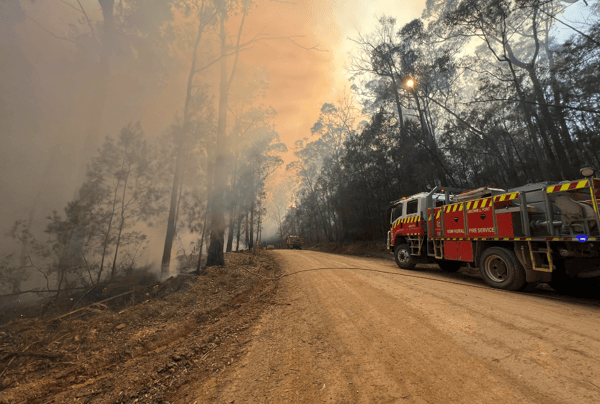This year's fire season has well and truly begun, and as we approach another Australian summer, the Bureau of Meteorology's (BoM) seasonal outlook has issued a sobering prediction - increased risk of fire danger in several regions for Spring & Summer. Memories of the devastating fires that raged across the continent in 2020 are still fresh in the memories of Australians, as countless bushfires left a trail of destruction in their wake, consuming homes, communities, and wildlife. The scars from that summer serve as a stark reminder of the ever-present danger that bushfires pose to those Australians who live close to bushland.
Recent fire events across the globe have also underscored the harsh reality that a changing climate is aiding the increase in the frequency and intensity of wildfires. It's a stark wake-up call that the threat of bushfires extends far beyond Australia's shores and requires a global effort to mitigate.
 NSW Rural Fire Service members fighting the Coolagolite Rd Fire near Bermagui on the NSW south coast last week
NSW Rural Fire Service members fighting the Coolagolite Rd Fire near Bermagui on the NSW south coast last week
(Image Credit NSWRFS)
In Australia, the recent shift from La Niña to El Niño conditions has added another layer of complexity to the upcoming bushfire season. While La Niña brought two consecutive years of increased rainfall and vegetation growth, El Niño typically ushers in drier and warmer weather patterns. This transition from a wetter to a drier climate cycle poses a new set of challenges, as the once-bountiful vegetation becomes susceptible to drying out, further increasing the risk of potentially more intense and devastating fires in the coming bushfire season.
Fire authorities across Australia are continue to prepare for the inevitable battle against the bushfire season, with important fuel reduction burns having taken place during the year across huge areas. While they do great work preparing for the upcoming season, the responsibility to safeguard homes, communities, and lives ultimately falls upon every individual, and it is important that households have a bushfire plan and have prepared their properties against the threat of bushfires.
Barkly Highway fire in the Norther Territory on 16 October 2023 (Image Credit Facebook)
How to prepare yourself and family:
Create a Bushfire Survival Plan
Develop a comprehensive bushfire survival plan with your family or household members. Discuss and practice the plan to ensure everyone knows what to do in case of a bushfire emergency.
Stay Informed
Regularly monitor local news, weather reports, and updates from your state's fire service or authority. They provide critical information about fire danger ratings, warnings, and evacuation orders.
Early Warning Network partners with many local councils who sponsor emergency alerts for their residents. To see if you are in one of the sponsored areas, visit our Alert FAQ Page.
Pack an Emergency Kit
Assemble an emergency kit containing essential items like water, non-perishable food, a first aid kit, torches, batteries, important documents, medications, and clothing. Keep this kit easily accessible in case you need to evacuate quickly.
.png?width=500&height=1250&name=Blue%20White%20Tips%20For%20Before%20A%20Flood%20Infographic%20(1).png)
Prepare Your Property
Clear flammable materials, such as leaves, debris, and dead vegetation, from your gutters and yard. Trim overhanging branches and remove trees that are too close to your home.
If possible, install metal screens on windows, vents, and doors to prevent ember entry. Ensure you have access to a reliable water source, a hose or hoses that can reach out the entire perimeter of your house, and check that your sprinkler system is working if you have one.
Store flammable materials and fuel away from your home.
Make sure your home insurance is up to date.
Plan for Evacuation
Identify multiple evacuation routes from your area, in case roads become blocked or unsafe. Ensure your vehicles have fuel and are ready for immediate evacuation.
Have a designated meeting point for family members if you become separated during evacuation.
Protect Pets and Livestock
Plan for the safety of your pets and livestock. Prepare transport carriers, food, and water for them. If possible, do not leave pets behind during evacuation.
Stay Calm and Informed During a Bushfire
If a bushfire is approaching, remain calm and follow your bushfire survival plan.
Listen to emergency broadcasts for updates and evacuation instructions, and if you are in a high-risk area, consider evacuating early to avoid the rush and potential danger.
Do not attempt to return to your property until authorities declare it safe to do so.
More Resources:
The state fire services have fantastic resources available to help you in preparing for bushfires and where to find even more additional assistance, along with the latest in Fire Bans, Fire Danger Levels and active fires. You can find links to all of them below.
ACT Emergency Services Agency
NSW Rural Fire Service
Northern Territory Fire & Rescue Service
Queensland Fire & Emergency Services
South Australian Country Fire Service
Tasmanian Fire Service
Victorian Country Fire Authority
Western Australian Department of Fire & Emergency Services
New Zealand Fire & Emergency